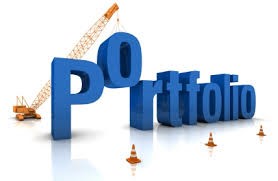
#4 in the series How to Manage Your Portfolio Effectively
If you’ve been reading along with this current series on tiering your donors, you know that we’ve now gone over what to do with A and B Tier donors. These two tiers, while comprising less than half, maybe just a third of your entire portfolio, will bring in about 75-80% of your total revenue. So obviously, this where you spend the majority of your time.
Your C Tier donors will account for about 75 to 100 in your portfolio of no more than 150; yet they will only provide 20-25% of your total revenue. This means that spending about 20% of your time (or 8 hours a week) on this group can be justified. That is 4 working days per month, or 48 days per year. I’m mentioning this to make sure you first keep this perspective on the amount of time you should spend on this group.
What Richard and I have found is that many MGOs have a really hard time gauging how much time to spend on their C Tier donors. The problem isn’t typically that they are spending too little time on them; the problem is that they are spending way too much time cultivating and stewarding these donors. Remember the story I wrote about earlier in this series, about the MGO who spent a bunch of time on one donor to solicit a $1,500 gift? That is the sort of thing that’s happening with many MGOs.
Again, it doesn’t mean that these donors are not important and don’t have value. It’s just that to be a wise steward of your time, you cannot in good conscience spend your organization’s money by taking half of your time on these donors. The math will not add up. And at the end of the year, you’ll have retention and value attrition problems with your “A” donors, on whom you should have spent more time.
All that being said, it’s doesn’t mean that you should completely forget about your C-level donors either. Remember, you have essentially one day a week to devote to this group. That is still a tremendous amount of time, if you think about it.
Let’s look at the chart below again to get a visual of what we are talking about:
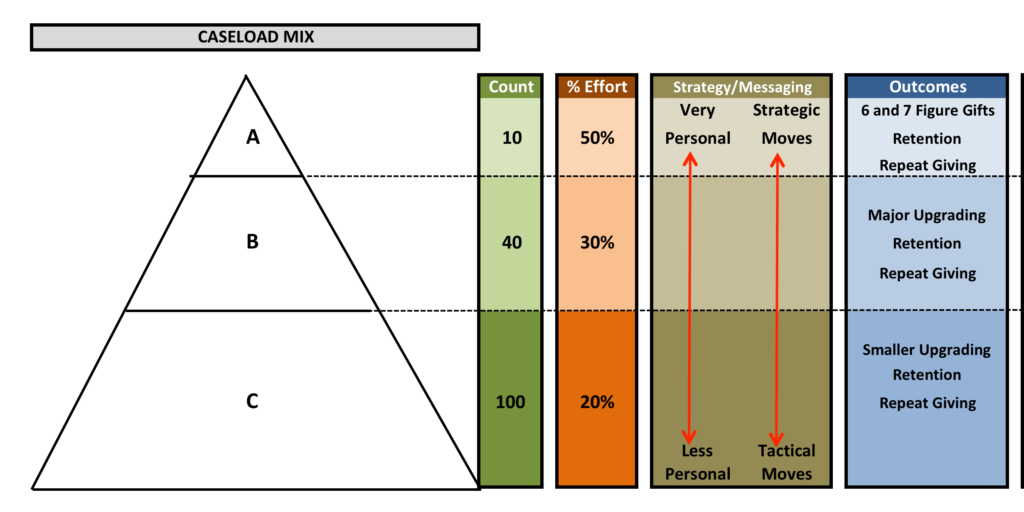
In this scenario, the C’s make up 100 donors, with 20% of your effort devoted to them. Your objective here is to try to upgrade these donors, make sure they are staying with you and giving year over year, and to also look out for donors that are starting to show more interest through their giving and involvement.
Remember that some of these C donors will become your A-level donors in one or two years. Others will perhaps move to B and stay there, and still others will simply go back into a mid-level program or your regular direct mail or annual fund program. The key for you is that you are always trying to identify those 25-30 donors in your C Tier who have real potential.
Here are some ideas for you for working with this group:
- Maintain their direct-response communications. Many times Richard and I run into major gift programs that take all of their donors out of the regular mail stream because these donors are on a caseload or they hit a certain giving level. The only way we would recommend taking them out is if you have now transferred the relationship to where the donor will only give through a direct face-to-face solicitation. Otherwise you risk (and we have seen this repeatedly) losing thousands, if not hundreds of thousands of dollars because donors will still give through those vehicles. So keep those C Tier (and for that matter your “B” and possibly your “A” level donors) in your regular donor communication stream.
- Thank them, and Report back. Any donor in your portfolio that gives a gift should be personally thanked by you… yes, even a C-level donor. Depending on the size of the gift, that may mean a phone call or a personalized thank you note, in addition to your standard receipting process. Beyond that, if the donor gives to a specific program or project, you will need to send a report. You should be able to work with program staff to help you put together a one-page document that will suffice.
- Monthly touches — Just like your A and B tier donors, you will create a monthly touch for your C tier donors as well, except that they will be less personalized, and more “mass produced.” For example, if you have a newsletter that goes out quarterly, you may put a sticky note on their newsletter, thanking the donor for their support. Whereas for an A level donor, you would have a note attached, specifically calling out an article for them to read, and hand-addressing the outer envelope. Make sense? The point is, you will create pieces that are more personalized than a regular donor would get, but less than your top-tier donors get throughout the course of the year.
- Yearly personal contact — With your C tier donors, you will want to make sure that you have some meaningful connections with every donor. That may mean a phone call, an email exchange that moves the relationship deeper, or a personal visit. Like your B tier donors, we would recommend a face-to-face visit with your top 25 to 50 of the Tier C donors, because those are the donors most likely to move up. In other words, you are tiering within your tier. The higher their giving level and capacity, the more attention you pay toward them. One strategy for MGOs who have a large territory to cover is to set up “anchor meetings” with two to four Tier A donors, then during the course of a week-long visit in a certain area, fill up the rest of the week with your B and C tier donors. That allows you to justify the travel time and cost.
- Biannual Evaluation — Twice a year we recommend evaluating your C level donors to determine how they are performing, and whether you want to move some up into B or even A level – or move them out of your portfolio altogether. If there are new donors that are waiting to get into a portfolio that demonstrate to you they have more inclination and capacity, you should replace lower-performing C donors.
- Watch out! While you can only spend 20% of your time and effort on Tier C, you also can’t forget them. There have been many cases that Richard and I have run into where the donor in a Tier C major gift program would be better off in a robust mid-level program, because the MGO has completely forgotten about the donor. If you can think of your C Tier donors as your acquisition pool for your Tier A, you probably would treat them better.
Now that we’ve covered all three tiers, you should have a solid strategy for each. The key is staying disciplined, and being focused on appropriately managing how much time and effort you spend on each tier. It’s critical to your success and ultimately to the type of relationships you form with donors. My final post in this series will be devoted to how you think about portfolio growth over time. It will be the icing on the cake of how to manage your portfolio.
Jeff
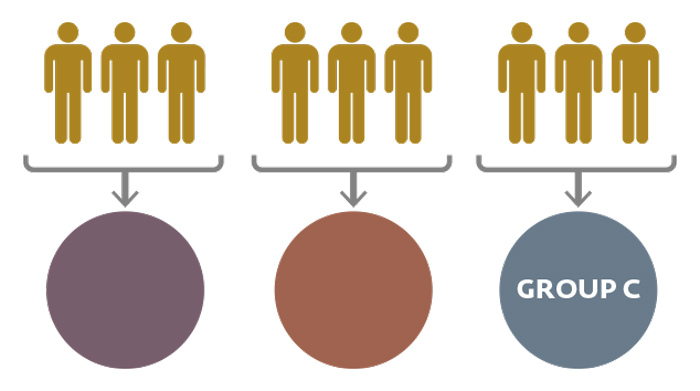
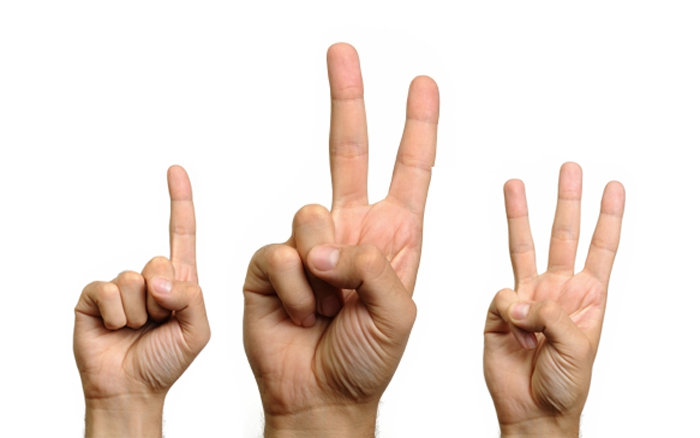
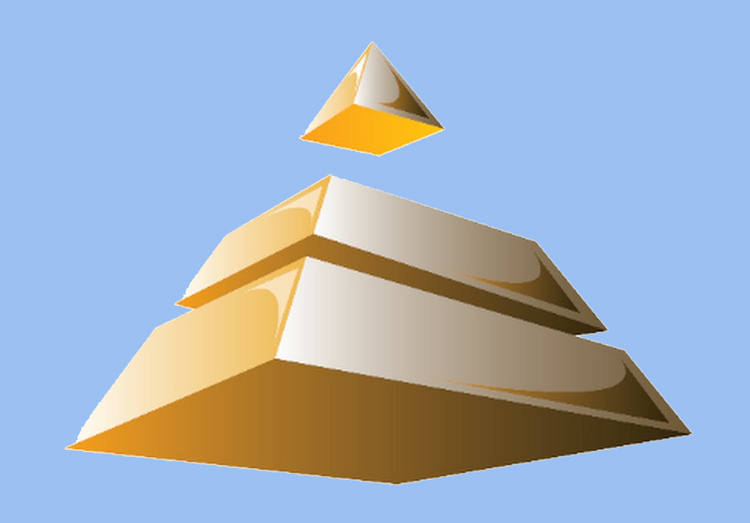




Great reminders. I especially like thinking of Tier C donors as the acquisition pool.